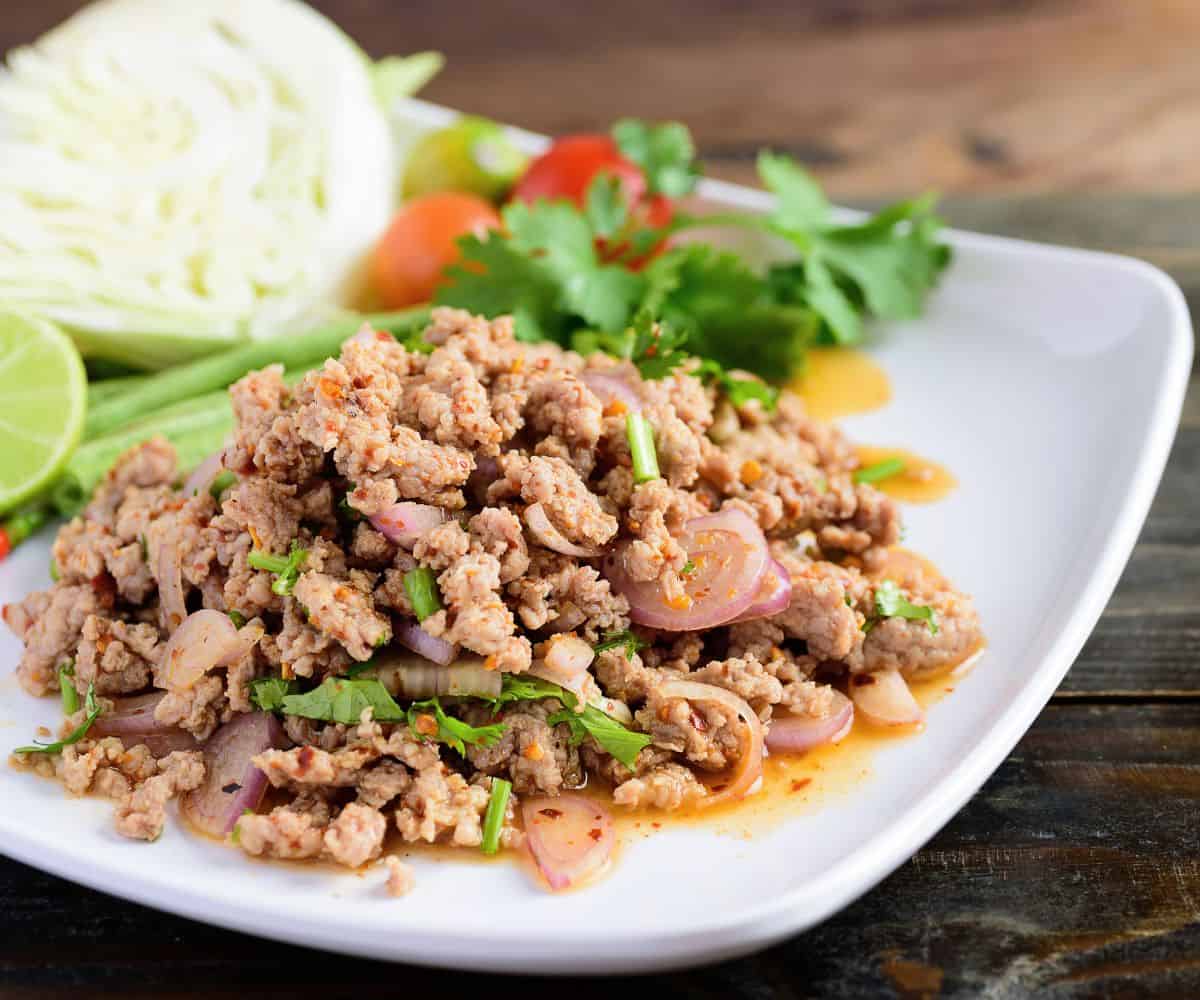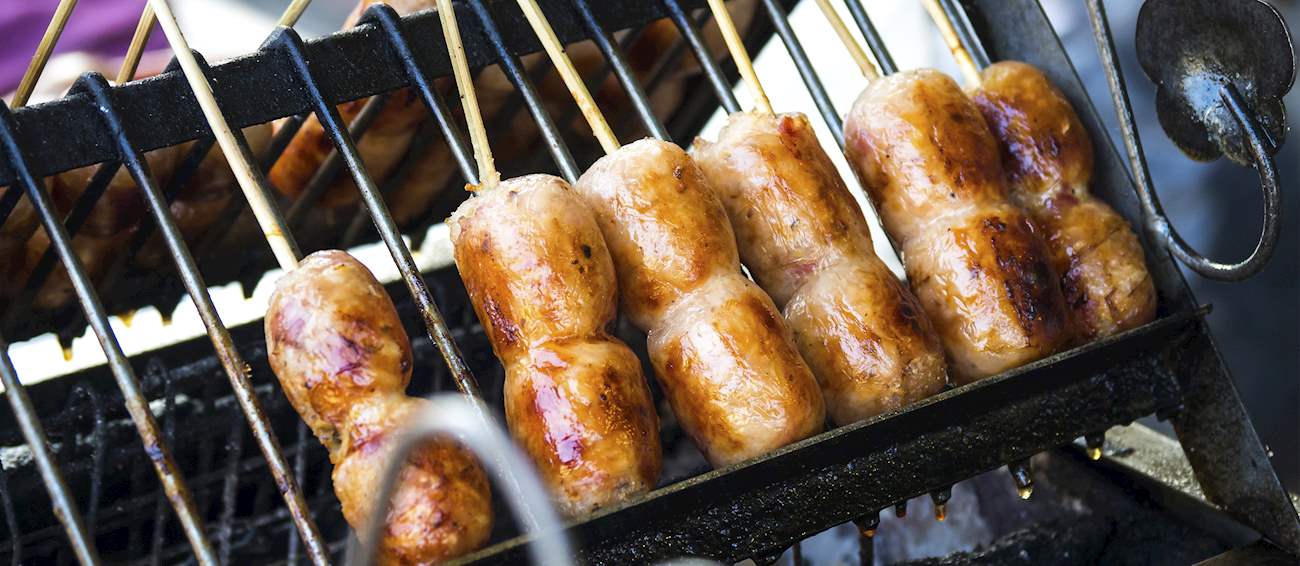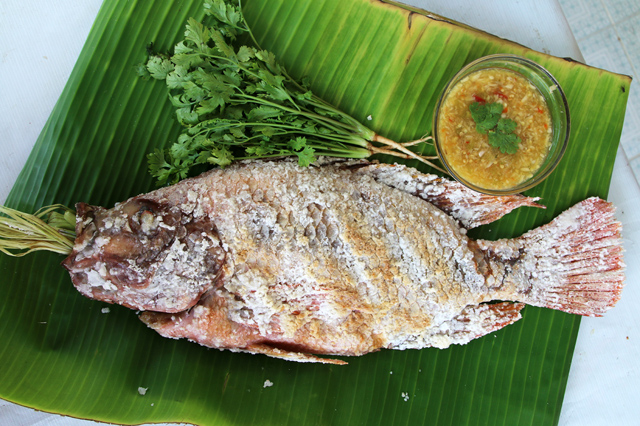Welcome back to the second part of that little introduction to Thai food. Previously, I introduced some Thai dishes from all corners of Thailand that I find delectable. In this follow-up, we’ll look at different savory dishes or meals, a Thai-style BBQ, and a dessert I love.
Must-Try Thai Foods from Isaan, Thailand
You may not have noticed this yet, but the dishes I chose to introduce today all share a common thread. For this second part, the must-try Thai dishes are sourced entirely from Isaan, Thailand’s vibrant northeast region.
Before, I also included several Isaan dishes, and there is a reason why it may seem like I have a slight predisposition for food from this region of Thailand. And that is, the food from this area has uniquely bold and delicious flavor profiles that I have never encountered before in Western cuisine.
Laab (or Larb) and Namtok: The Bold Heart of Isaan Cuisine

Namtok this and namtok that! Everywhere a namtok tok! Laaaaaab! (Imagine a newsie’s cry) Getcha laab here! You can find a lot of namtoks and laabs — they are popular dishes. Namtok/Laab Gai (chicken), Namtok/Laab Muu (pork), Namtok/Laab Neua (beef), Laab Phed (duck), Laab Pla (fish), Namtok Pla Muek (squid), Namtok Talay (seafood) — there is an endless variety of laab and namtok.
So what are they? Laab and Namtok are very similar. These are salads consisting of some sort of protein, a mix of Thai herbs (cilantro/saw weed, mint, celery leaves, chives), onions, tomatoes, and a lime–fish sauce–based dressing. The difference between Laab and Namtok is that the protein in Namtok is sliced, while the protein in Laab is minced. Both types of these dishes are very refreshing, light, and pair well with Somtum and sticky rice (Khao Niaow).
If you’re teaching English in Thailand, you’ll probably see these dishes on local menus near your school. They’re some of the best introductions to authentic Isaan food — perfect for adventurous teachers and food lovers alike.
Sai Krok Isaan: The Street Food Classic

Another dish that would complement a Laab or Namtok on a table spread would be Sai Krok. You may have seen these before — the dainty little grilled sausage balls you’ve probably passed on the street. Sometimes, you’ll see the vendors on their retro-fitted bikes or with their pushcarts displaying strings of sausages over their grills.
There are two types I have come across: sour (briaow) and regular (ta-mada). The sour ones are made with fermented pork, giving the sausage a slightly sour, garlicky taste, and sticky rice or rice noodles. The regular ones are made with seasoned minced pork and sticky rice or rice noodles.
I, being a big supporter of flavor, prefer the sour ones, but this could be too intense for some people. The smell of them being grilled is intoxicating — the air wafts with the aroma of pork and garlic, somewhat reminiscent of a backyard brat or other sausage.
These sausage “daddies” are served grilled on a stick, accompanied by raw cabbage, raw green chilies, and pickled ginger (probably to give you some breaks between garlicky bites). I’ve even tried them with Dijon mustard in my condo — surprisingly tasty, as the pickled ginger helped clear the palate of those bold flavors.
Pla Pao: Salt-Roasted Fish You Can’t Resist

Have you ever walked by a restaurant and seen a big coal grill with fish roasting on top? Are the fish all stuffed with little herb bundles? That’s Pla Pao, or salt-roasted grilled fish.
I remember the first time I saw this in front of a restaurant in Sathorn, by BTS Surasak. The fish were on self-turning spits over a charcoal grill. The smell was so inviting that I eventually accepted its invitation.
From what I’ve seen at most shops that sell Pla Pao, it usually comes with some accompaniments: leafy veggies (cabbage, lettuce, herbs), Kanom Jeen (fermented rice noodles), and sauces — typically spicy, citrusy Nam Jim Talay (seafood sauce), spicy pepper sauce, or sweet soy.
Your order often comes packed as a set: a perfectly cooked whole tilapia, a bag of leafy greens, a small bag of Kanom Jeen, and two or three sauce baggies. It’s a meal for two small to medium eaters, or one big-medium to biggish person.
Take some of the fish, wrap it in lettuce, add some saw weed and dill, a bit of Kanom Jeen, dip it in the seafood sauce — and damn, that’s a delicious morsel.
Kanom Krok: The Sweet Finale

As we started boldly, we should end on a sweeter note to bring a little balance. I’ve eaten many Thai desserts since being in Thailand, though I can’t recall most of their names. Many are fascinatingly delicious, unlike anything in Western cuisine.
One standout I indulge in occasionally (used to be more frequent 🥴) is Kanom Krok. No, these aren’t dessert sausages (😂). They’re coconut pancakes with coconut custard and toppings like taro, corn, Foi Thong (sweetened egg yolk floss), pumpkin, banana, or chive.
They’re sweet, creamy, and very easy to eat. If you ever visit a night market, you’ll find Kanom Krok stands — they look like small concave pancakes with a white filling (coconut custard) and colorful toppings.
Eat them however you like! I dip them in cool coconut milk when they’re warm. Be careful, though — they’re cheap, delicious, and dangerously addictive 😋
Moo Krata: The Thai BBQ Experience

I think most have either had a Korean BBQ experience or know someone who has. But how many have had a Thai BBQ experience — or know someone who has? Do you know Moo Krata? This is the self-serve Thai-style BBQ, and to me, it’s just a step above the Korean-style (not by much though 😘).
There are so many Moo Krata restaurants! They’re stand-alone, on sidewalks, in night markets, and even across the street from my condo. Some operate as buffets where you pay for an all-you-can-eat experience for an allotted time, while others operate like tapas — small plates you grill yourself.
There are so many things to grill: thinly sliced pork and beef, baby corn, pumpkin, mushrooms, tofu, morning glory, and seafood like shrimp, squid, and fish. Some premium ones even have crab and prawns.
So far, I’ve seen two styles — dry-grilled and grilled with a moat for broth. Go with the moat if available! The moat is filled with broth heated by coals. As the meats grill, their juices drip into the broth, deepening its flavor. Over time, that broth transforms into a rich, delicious soup.
This experience calls to anyone who loves to socialize, grill, and eat — the ultimate comfort for teachers and friends enjoying the weekend after a long week of lessons in Thailand.
The Adventure Continues…

I hope this lovely addition to Thailand’s culinary delights has been helpful. Maybe it got you curious, maybe it calmed your nerves about exploring new food territory — or maybe it tempted you even more.
What I do know is this: Thailand has a remarkable culinary culture. It’s bold, unfamiliar, and a great avenue of exploration for anyone who’s open-minded and flavor-curious — especially teachers living and teaching in Thailand.






![[BFITS] Be Like Greg_Exploring Opportunities and Embracing My New Teaching Role in Thailand](https://bfitsthailand.com/wp-content/uploads/2025/03/BFITS-Be-Like-Greg_Exploring-Opportunities-and-Embracing-My-New-Teaching-Role-in-Thailand-300x109.jpg)


![[BFITS] BrightMinds Series_The Future is Yours KickOff Session on Expert Insights for Your Future Career with Mr. Suthichai Yoon](https://bfitsthailand.com/wp-content/uploads/2025/01/BFITS-BrightMinds-Series_The-Future-is-Yours-KickOff-Session-on-Expert-Insights-for-Your-Future-Career-with-Mr.-Suthichai-Yoon-300x109.jpg)








